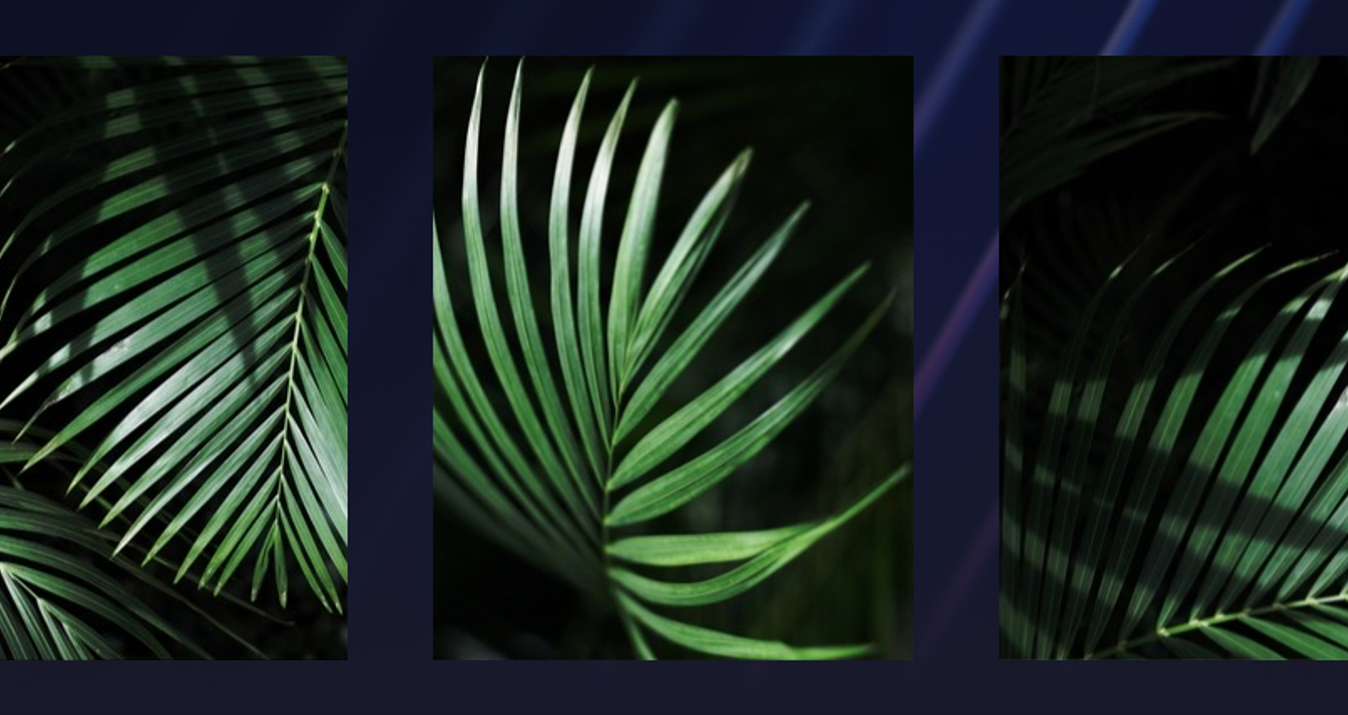Check out this exclusive behind the scenes look at Jack's adventure to capture the 61G ocean entry.
The “Adventure” started when our friend Jack Fusco had an idea to capture a time-lapse of the night sky with the ocean lava entry in Hawaii. This was the first time in over 3 years that the lava flow was entering the ocean and it promised to be an epic trip. After checking the weather reports, moon phases and Hawai‘i Volcanoes National Park website to verify the flow was still moving, we took the plunge and booked our tickets.
We knew the schedule might be a little tight given the uncertainty of the weather and viewing conditions, but we were confident that we would be able to capture what we came for. Of course, when we arrived at the Kona Airport (Ellison Onizuka International Airport), we were immediately greeted by rain. With the drive from Kona to our hotel in Hilo just over 75 miles, we were hopeful that the weather would change. Unfortunately, the clouds stayed and the rain did not let up.
Once we checked into our hotel, we connected to the wifi and found out that the lava entry viewing area was being pounded by rain as well, and the conditions were not only dangerous, but there was no sign of the clear skies we were hoping for. After learning this, we pivoted to to see if we could make our way above the clouds. Mauna Kea was our new destination today.
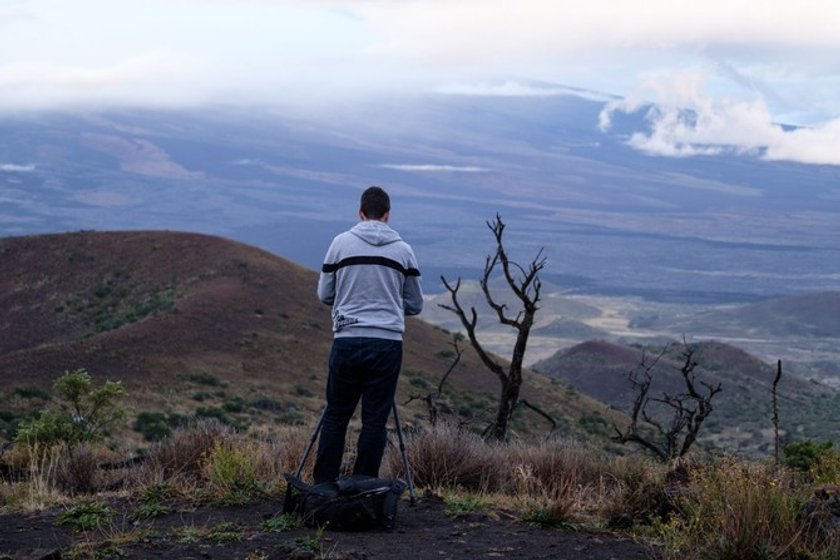 The image above was taken at a turnout about a mile from the visitor's center Mauna Kea.
The image above was taken at a turnout about a mile from the visitor's center Mauna Kea.
The 42-mile drive would take us about an hour and a half, and though it was beautiful, the sky still had not opened up as we had hoped. Once we made it to the visitor’s center we were disappointed to hear that the road up to the top was closed: over the past 24 hours they received quite a bit of snow, and access was restricted to official vehicles only, crushing our hopes to rise above the clouds to see clear skies.
Feeling a bit frustrated, we stopped for a quick coffee, then continued to the summit of Kīlauea volcano. The glow from the lava lake within the erupting summit crater, Halema‘uma‘u, is visible from the Jaggar Museum observation deck (open 24 hours a day). The rain was still falling, but the glow of lava lake and steam was hypnotizing. We grabbed our cameras and set up to capture the swirling smoke and steam as it danced with the incoming clouds.
After about 45 minutes the rain began to fall with even more intensity, and since our vision was limited, we packed up for the night. Back at the hotel, we offloaded our footage and charged our batteries for the following day.
Early in the morning, we re-packed our gear and hit the road. After a quick stop at the Kīlauea Visitor Center to get the latest news on the lava entry viewing area, we headed down to one of the two starting points to access the 61G lava flow viewing areas. Per one of the park ranger's recommendations, we decided to take the route from the Kalapana. This route is a hike along roughly 4 miles of a gravel road and then about 1 mile over uneven hardened lava flow and steam vents. Extra fun with 65 lb. backpacks full of gear!
When we arrived, we were surprised to see the viewing area mostly empty. However, as we waited and watched over the next 10-12 hours, many people came and went. At times the viewing area had people shoulder to shoulder about 5 rows deep and 50 bodies wide, and at other times there were only a few people at the rope line. Surprisingly, it seemed like most people only stayed for a few minutes after hiking over an hour to get to the viewing area. What we discovered while there, was that conditions change minute by minute. Fortune truly favors the patient. A cloudy sky could turn clear within an hour, rain will come and go in a matter of minutes, the direction of the plume could change at a moment’s notice (more on this later) and the visible activity of the lava entering the water updates continuously.
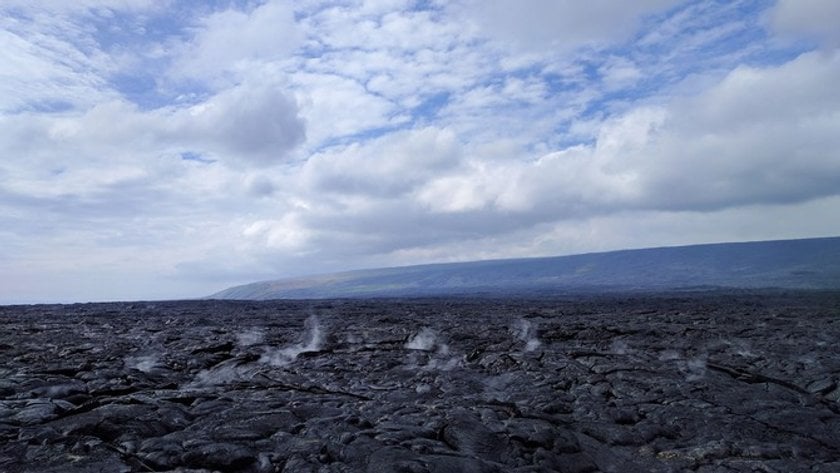 The above image shows the terrain that followed the gravel path. Steam vents can be seen peeking through the lava field.
The above image shows the terrain that followed the gravel path. Steam vents can be seen peeking through the lava field.
When we finally decided to make our way back to the car over the hardened lava and gravel road 12 hours later, the full weight of our packs seemed to hit us simultaneously. As we strapped our packs on for the journey back, we both looked at each other with a sort of shared anguish; we were not looking forward to the hike back. We made it back without incident, but decided to make different travel plans for the following day.
On the drive back to the hotel, we stopped by the Jaggar Museum observation deck, and rushed out of the car as fast as we could staring at the open sky above us. Jack set up his first camera, I managed to take a couple of test shots, and before Jack could set up his second camera, the sky closed. The brilliant twinkling stars that only moments ago filled the sky, were gone; obscured by fast-moving clouds that quickly reduced our visibility to only a few feet in front of us. We waited a few minutes more in the car hoping the sky would clear again, but it didn’t. The hotel beckoned us for some rest.

Each of the images above were taken about 5-10 seconds from each other. As you can see from left to right, we went from partial visibility to complete blackout in under a minute!
The next day, we spent a lot of the morning transferring the footage from the day before. Afterwards, we had a quick breakfast, then headed directly to the Kalapana entrance to the viewing area. Before unpacking our gear, we did a quick survey of the vendors offering bike rentals and found one that offered the latest possible return time. We chose our bikes, paid the fee, then headed back to our car to gear up and go.
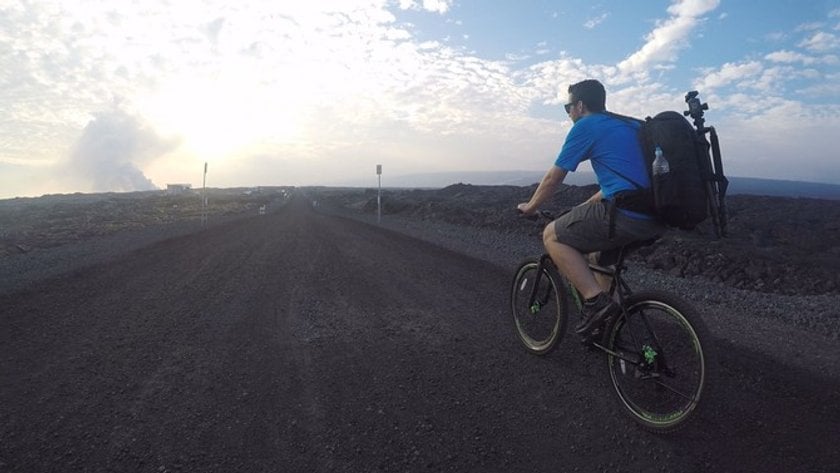
The above image is a still image from a GoPro video we captured while biking to the lava entry on our second visit to the ara.
The journey this time promised to be much faster, and as a result we both felt an initial rush of enthusiasm. The packs on our back, however, made the ride in a bit more challenging than we expected, but we still made good time. We arrived about 30 minutes before sunset, and as we made our way to the viewing area, we quickly discovered it would be a challenge to find a good spot before the sun went down. The area was packed with people and even the areas well behind the rope were filling up. Luckily, a very kind fellow photographer was about to leave, seemed to sense our urgency, and offered for us to take his spot on the line. We gladly accepted and Jack quickly set up his shot before the sun went down.
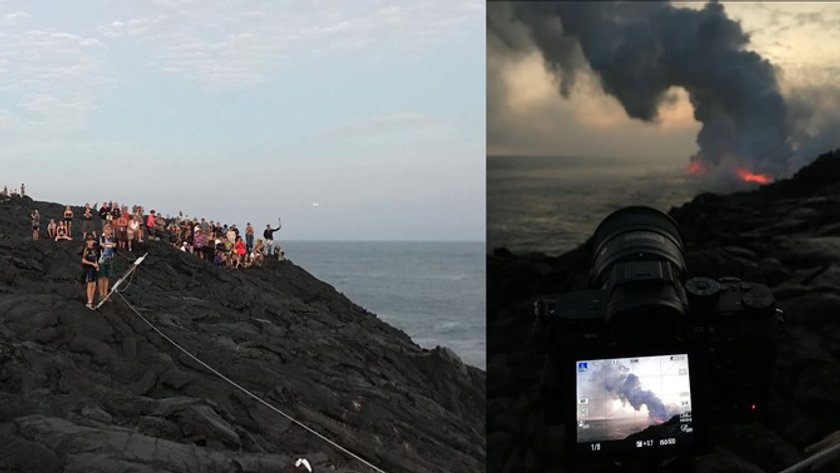
Left: Viewing area facing away from the Lava Flow. Right: Ocean Entry view facing the flow at the rope line.
The combination of the setting sun, moving clouds and undulating volcanic plume made for some incredible shots. As the clouds came and went, we were optimistic that we would be able to get the coveted stars + lava entry shots we based the trip on, but after waiting over 8 hours for the moon to set, the wind shifted and the plume started to move in our direction. We waited a few more minutes to see if the winds would change back, but the plume only seemed to get closer, so we made the decision to pack up our gear before we were in danger.
Though we were initially discouraged and a bit disappointed, the road offered a unique perspective that obscured much of the bright areas of the lava flow, while still allowing a view of the illuminated plume. Though not ideal, the compromise in composition more than made up for the increased level of safety. We both captured a few more sequences, waiting for the wind to change. It never did, so we packed up our gear, jumped back on our bikes, and rode back to the car at about 2:30AM!
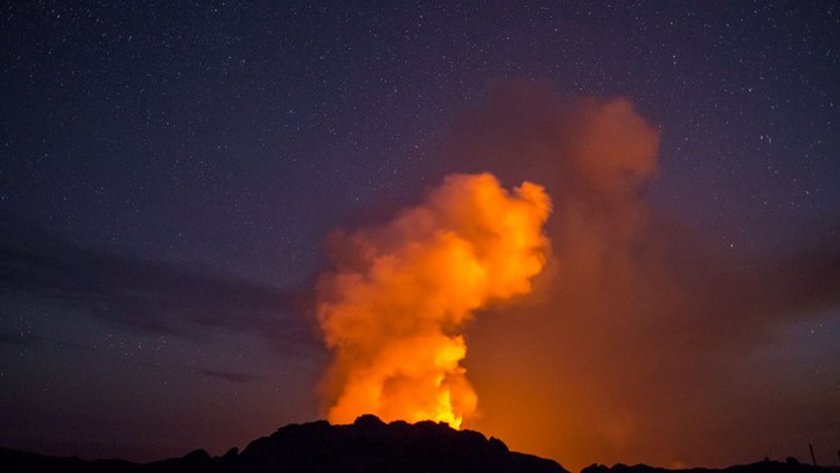
The image above was taken from the road after we had to relocate due to the volcanic plume moving in our direction. Sigma 20mm f/1.4 DG HSM Art Lens, Nikon D800E
Once we returned the bikes and were back in the car on the road, we decided to go back one last time to the Jaggar Museum in hopes that the clear sky would follow us. This time it did, and more importantly the clear sky lasted long enough for Jack to capture some incredible sequences of the crater with shining stars in the distance. The resulting images seemed extraterrestrial as if juxtaposed with a sci-fi character it might be mistaken for another planet. Feeling confident we captured what we came for, plus some bonus material we made the final journey back to our hotel to get some well-deserved rest.
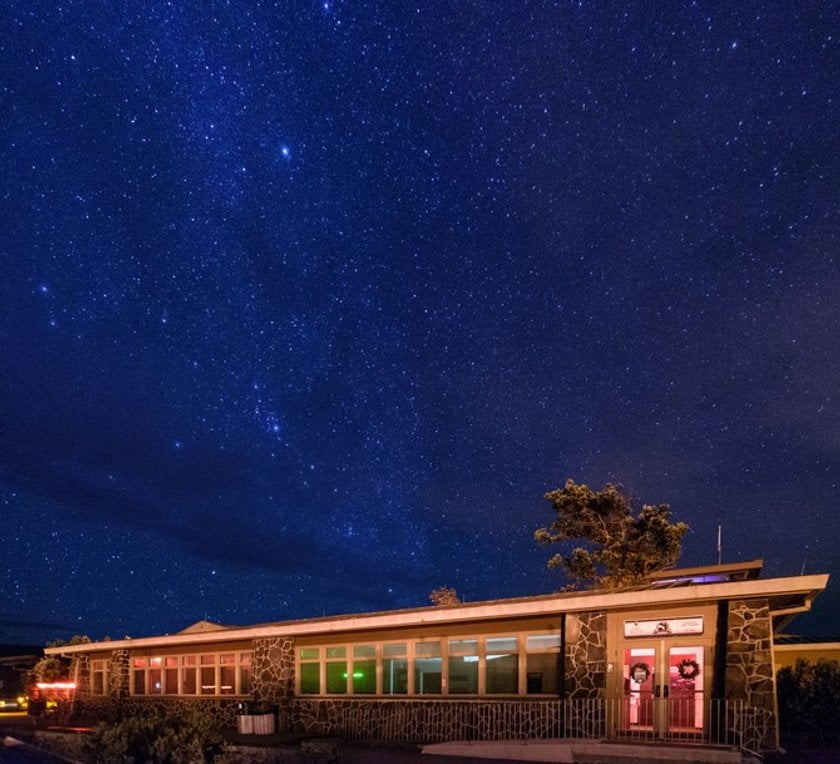
This is an image of the Jaggar Museum, it is right on the edge of Kīlauea caldera, and the Halemaumau Crater is one mile away. The light illuminating the building is mostly from the glow of the lava.
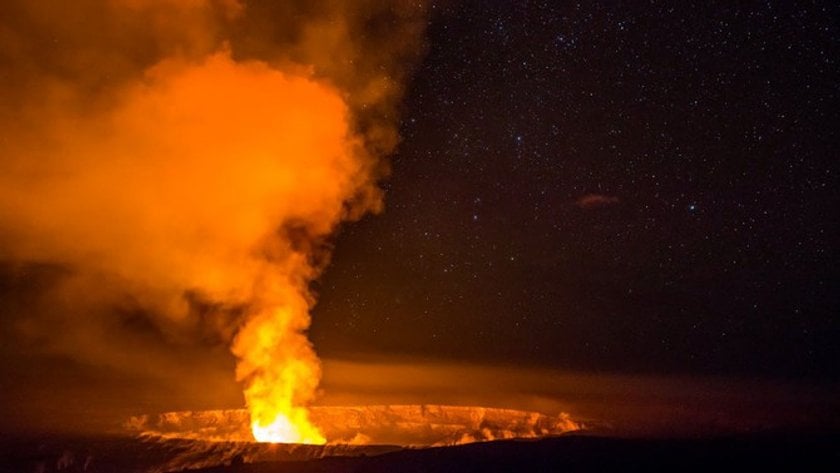
This is an image of the Hale Ma’uma’u Volcano Crater with a clear sky viewed very close to the Jaggar Museum. Sigma 20mm f/1.4 DG HSM Art Lens, Nikon D800E
Over the course of the 4 days and 3 nights we spent on the Island, we:
- Flew: 5110 Miles
- Drove: 546 Miles
- Hiked: 20+ Miles
- Slept: < 12 hours
- Captured: 1.3TB of Data
When we were initially planning this trip, we were both optimistic about the opportunity to capture such an amazing phenomenon. We knew that the task would be challenging on such a tight schedule, but our persistence and willingness to wait for the best possible conditions rewarded us with an experience neither of us will soon forget.
Soon after we returned to California, the viewing area we were standing in to capture many of the sequences, collapsed into the ocean along with almost 25 acres of newly formed land from the lava flow. You can find out more about the incident on the Hawaii National Parks website here. But hopefully our video will serve as evidence you can capture incredible images while following the local guidelines and restrictions created to ensure the safety and wellbeing of onlookers.
Jack's Gear List:
Camera Bodies: Sony A7RII, Nikon D800E
Lenses: Sigma 20mm f/1.4 DG HSM Art Lens, 24mm f/1.4 DG HSM Art Lens, 50mm f1.4 DG HSM Art Lens, 50-100mm f/1.8 DC HSM
Tripod: Feisol CT-3442
Timelapse Rig: Rhino EVO, Motion, ARC
Software: Skylum Luminar, Adobe After Effects, Adobe Premiere








